Begonia Emptying is strongly loved by flowers due to its grace, compactness, modesty in care, and abundant exotic flowering throughout the year. Scarlet, Baggon and White Begonia buds are dismissed without delay, which served as the cause of such a name of culture. But how to grow and multiply this sophisticated flower on the windowsill, and what are the requirements of the Begonia Emerging?
Botanical Features of Begonia Emerctive
Begonia's discoverer, which made a botanical description of the kind, became Charles Plumia. He was a monk who traveled actively with the aim of collecting and studying wild cultures. In the middle of the XVII century, he arrived at the Antilles, where he met this magnificent blooming fragrant flower. The name of the culture was assigned in honor of Governor Haiti - Begona.
Motherland Begonias consider the western part of Africa. There is a hypothesis that, from this hot country, Begonia moved to America and Asia. However, even today in Africa, a third is actively blooming from the entire variety of types of begonias.
Begonia Emerctive or BEGONIA Semperflorens is the largest representative of the Begonian family. Rod has more than 1000 subspecies, the natural range of growth of which are mountain slopes, tropical forests and subtropics. Mostly begonias are found in the southern strip of America. But a lot of species grows in the mountains of India, the Malay archipelago, as well as in the Himalayas.
Given the enormous popularity of Begonias in home flower growing, almost 2 thousand hybrid species and varieties were displayed. They differ among themselves form, color of inflorescences and leaves.
The general distinctive features of the genus of eternal begonias are considered as follows:
- Begonia is a mid-grade bush culture with straight shoots that can grow up to 55-60 cm in height.
- Adult plants are slightly modified, and straight shoots acquire an ampel form.
- Flowers of the begonias of the eternal-drying can be large or medium. The diameter of the revealed bud 2.5-5 cm.
- The leaves of the begonia of the ever-flowing round shape, weakly-minded around the perimeter. The magnitude of each sheet varies from 4 to 6 cm, the color can be different - light or dark green, less often with a red tide.
- Flowers are tied by groups in inflorescences, quickly faded, constantly changing the new ones. With proper care, it is blooming without ceasing.
Begonia Emerctive: Home Care
This is a plant, although it fell to us from rainforest and mountainous locations, perfectly adjusted for a new climate. Begonia is undemanding in care and care always meets long blossom. But this culture is very wayward and loves constancy in living conditions. Therefore, it is necessary to think over everything to the smallest detail until the begonias landing into a new pot and ensure comfortable climatic conditions at home.
Optimal conditions for Begonia Emerctive at home
Begonia is one of those plants that do not stand the frequency change of the area of \u200b\u200bthe vase in which they grow. Therefore, once and forever choose a place where we set up a new flower - a light and spacious window sill with an eastern or west side, but without direct sunlight. Comfortable air temperature for begonia - 18⁰s and more, and both in summer and in winter.
The tropical origin of Begonias led its need for high humidity. But abundant spraying of the plant can spoil the decorativeness of foliage - it will cover brown stains. The best way out of the situation will create an artificial source of moisture. To do this, in the empty pallet put another, but inverted upside down a little smaller size. Then to put a pot with begonia on top. Circle the inverted pallet scatter a little clay and constantly moisturize it. The evaporating water will serve as a source of moisture for begonias. Or you can simply install the houses an electric air humidifier near Begonias.
An important nuance in choosing a place for begonias of an eternal room - sufficient space. The flower does not like close neighborhood, so you need to provide him with a lot of free space on the windowsill.
Begonia needs a constant influx of fresh air, but the ventilation must pass without the presence of an open draft and a sharp temperature difference. For such conditions, Begonia will immediately reset the leaves and fading inflorescences.
Suitable soil and pot for Begonia Emerctive at home
Begonia is well rooted, increasing the foliage and fully flowers only in a suitable pot. For Benging, you need to choose only ceramic containers that provide soil microcirculation. The diameter of the vase is needed by 3 or 4 cm more than the root tube of the plant. If the rompa is wider, the soil will be rejected and bloom will be small, short or not coming at all.
Soil with optimal composition for begonias is better to purchase ready. In flower shops there is an excellent choice of soils for such plants. But you can make it and at home: two parts of the leaf land and part of peat, humus and sand.
Since the rhizome of begonias has surface accommodation, the soil must be very light, porous. A suitable pH for begonia should be weakly acid (from 5.5 to 6.5). Express alkali in the soil will contribute to the development of disease.
Begonia Emerctive at home, landing
To plant a begonia in a pot is easy if you do it carefully and consistently. The landing should be carried out in March, when the length of the sunny day is already sufficient.
Technique planting Begonia Emerctive:
- A third of the volume pots are removed under drainage. A thin ball of charcoal (2.5-3 cm) is placed on top of it (2.5-3 cm) with the aim of preventing the rotting.
- Then the root tube is lowered in the pot with a lump of land, and gradually fall asleep all the empties prepared soil.
- The last stage of landing is watering begonias. You need to make enough water so that the soil is completely moistened.
Watering and a chart of fertilizer of Begonias ever-flowing at home
Watering plants must be balanced. Begonia Emerctive homemade is very moisture, but watering should not be frequent. It is much more important to provide high humidity of air, otherwise the leaves will be filled at the tips, which will strongly spoil the decorativeness of begonias.
In frequent watering, Begonia needs only in very hot days. But during this period you need to constantly monitor that surplus water do not delay near the roots. The need for another watering is checked according to the degree of bread debris: when it dries to a depth of 1.5 cm, you need to pour begonia again. In winter, watering is doubled by halving, while increasing the level of air humidity, especially if the pot stands near the heating devices.
Important! Begonia can only watered with an estate and warm to room temperature with water.
Fertilizers are very important for the normal development of the begonia of the ever-drying, so care necessarily includes regular feeding. At the stage of education, phosphoric-potassium fertilizers are used. And on the moment of the bootonization every two weeks, liquid fertilizers are made for flowering crops.
Transplanting Begonias Emerctive Home
Current care necessarily provides regular plants transplantation, since Begonia is rapidly increasing the root system. It is time to make it time to resettle a begonia in a little more, it is possible through the protruding roots from the drain hole. Transfer only early spring until growth has been activated.
Begonias transfer is carried out like this:
- The plant is neatly removed from the old pot.
- The root system is carefully cleaned from the remnants of the Earth.
- The roots are immersed for half an hour in a weak solution of potassium permanganate.
- Then the roots are rinsed with estate water, shut off the root roots.
- When the roots get angled, they are planted in a new vase according to the scheme described above.
- The vase is put on the previous place and the first few days often watered.
Important! Mature plants with which more than three years need to be divided during a transplantation. This allows the plant to update and more actively bloom.
Crouching Begonia Emerctive at Home
It looks much better than begonia, growing in width, and not height. Removal of unnecessary shoots perfectly stimulates the development of begonias and allows you to create a beautiful neat shape. Crossing Begonias spend when it rapidly starts pulling up, gaining awkward look. So that she accepted rounded shape, the upper stems are left long, and those that near the base make a little shorter. It is also important to ensure that the number of leafs is the same on all sides.
Advice! Cropped bunches of Begonias eternusing throwing no need. They can be successfully rooted to obtain new bushes of this plant.
In order for Begonia to do not lose their kind, regularly break extra shoots. When the cropped areas are achieved more than 14 cm, it should be isolated by their clamps. It will not let the shoots further grow and will stimulate their branching.
The reproduction of Begonias ever-flowing at home
Room begonia is multiplied by the seed method, the division of the root, rooting of leaves and cuttings. In all cases, this happens quite easily and quickly, but a vegetative method of breeding is more accessible.
Growing Begonia Emerctive SEeds at Home
To grow begonia from the seeds, at the end of February, seeding seeds in loose soil, without deepening seeds in the substrate. Then the container with seeds is covered with a film and put in the warm room.
It is important to regularly wipe the condensate on the film so that it does not harm the seeds, and they did not hesitate. It is possible to solve this question differently: put a container with seeds at a low angle. It is also recommended to cover the film or glass paper until the appearance of shoots.
Water seeds through the pallet or irrigation with the pulverizer as the soil drying. When shoots will be processed, the shelter is cleaned, and after the formation of three full-fledged leaves, they conduct a pickup.
After 60 days, the seedlings are cleared into individual pots. With additional lighting, bloom is possible in the first year.
Begonia Emerctive Home - Reproduction Sheet
Extracting Begonia quickly multiplies with sheet plates. The rooting is carried out as follows:
- In the lower segment of the sheet plate, sucks are cut.
- In the calcined sand laid the sheet with the bottom side and fixed.
- Regularly moisturize the soil through the pallet.
- Full rooting occurs after 2 months: roots appear in the sections, and after them new bushes.
- At this stage, the formated plants are separated and carried out landing into an individual pot.
Begonia Emerctive at home - reproduction with cuttings
Grow begonia from the cutter, probably the easiest. With a bustle, cuttings with several leaves are cut off, cuts are well lubricated with charcoal, and planted into the substrate (sand river, peat, as well as leaf land in equal shares).
Capacity with cuttings is kept in a well-lit place without straight rays of the sun. Water cuttings, if necessary, soil soil have time to dry between irrigation. You can also make rooting right in the water. For this, the cuttings are immersed in water capacity for 2 months.
Pests and diseases of the Begonias eternal at home
There is always a risk of damage to the begonias of aphid, a spider tick, and nematoda. The wave and mites are used by the juice of Begonias, so after infection, the flower fades dull, loses the leaves, lags in growth.
To destroy the Tly, you can use accutellik. It will take only three treatments with an interval of about 10 days. To get rid of the ticks, any inhibitoacaricide is suitable, for example, derris. In the event of nematodes, it is almost impossible to save begonia, so there is a plant to throw out a plant.
Home Begonia is sick with mildew, gray and black rot. It is possible to solve the problem with a fungicide - quadris or burglar liquid. There are also begonias such as spotting tomatoes and cucumber mosaic. Such diseases provoke the appearance of yellow specks on the foliage. It is impossible to cure begonia in this case.
Sometimes the deterioration of the appearance of the begonia is caused by non-bacteria or pests, but the wrong leaving for it. If the plant began to suddenly dry without signs of the disease, most likely, the apartment is too hot and Begonia suffers from moisture deficit. Changing the problem can be adjusted by watering mode.
The appearance of yellow drooping leaves is the result of the opposite situation: water in the vase is too much and begonia starts to heat. In this case, watering should be reduced.
Begonia Emerctive - Popular Sorts
The best varieties of this culture include:
- "Accord" - a hybrid begonia to a height of up to 30 cm. This variety is also suitable for home cultivation, and for planting in open ground, but for the winter it needs to be taken home. The plant is increasing a round foliage with a bronze sweat, which has increased decorativeness. It makes little flowers in small (up to 3 cm) with flowers of gentle pink color.
- Bad Bing - a thermal-loving average begonia bush with bright green foliage. The height of the bush is 20-25 cm. Color of inflorescences are different - crimson, milk, scarf, red. Actively blooms for a whole year, on the summer it is possible to plant in the garden.
- "Gustav Knapa" - a sprawling bush growing up to 30 cm. Green leaves with a dark red rumble; Complicity large, saturated carmine shade.
- "Bicola" - low-speed begonia (up to 15 cm). For a variety, the genuine color of the leaves, and gently white flowers with a pink edging.
- "Amber" is a common homemade variety of begonias. It grows up to 14-16 cm, richly flowers with small pink flowers.
- "Queen" is the Begonia eternal terrain. A low branchy bush, which is characterized by a rich wipes of red or dairy petals, which gives the flower the effect of terryness.
- "Oranya" is a small bush with dark green leaves, along the edges painted in red; Flowers are large, red-orange.
- "Carmen" - the plant of the average size, with the leaves of brown, on which the anthocian is visible - the spin of red and purple. Inflorescences of pure pink shade.
Begonia Emerctive will decorate any room interior or revitalize the facade of the house. In gratitude for your care and attention, it will delight you with colorful bloom throughout the year!

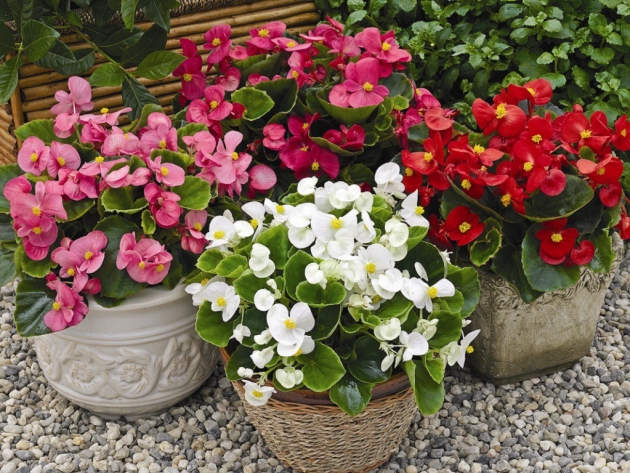


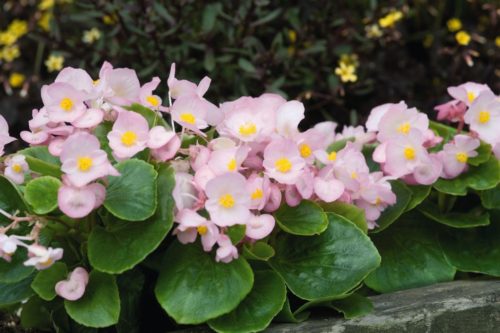
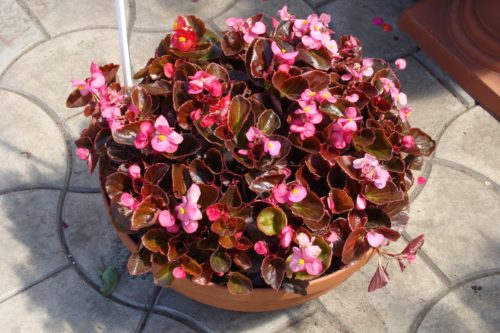
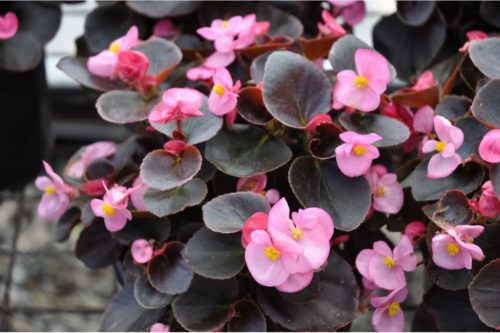
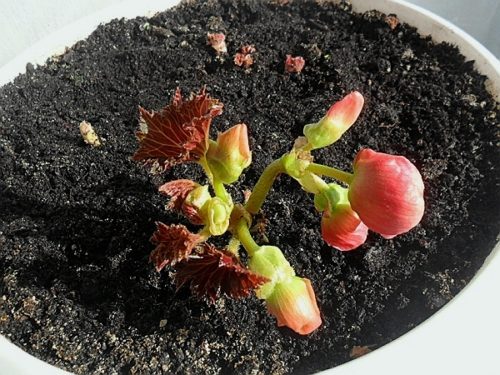
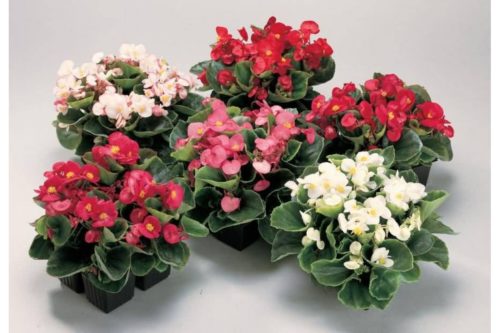
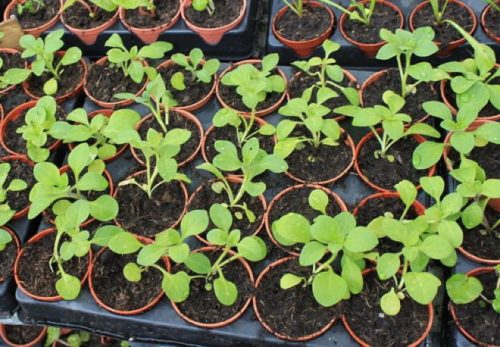
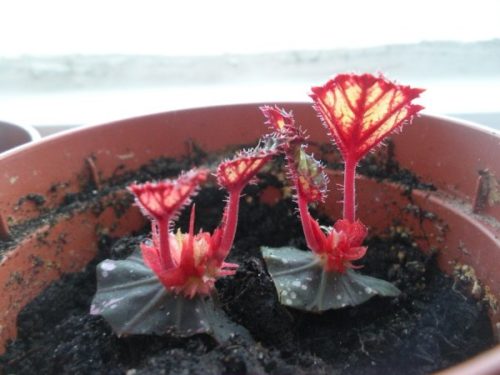

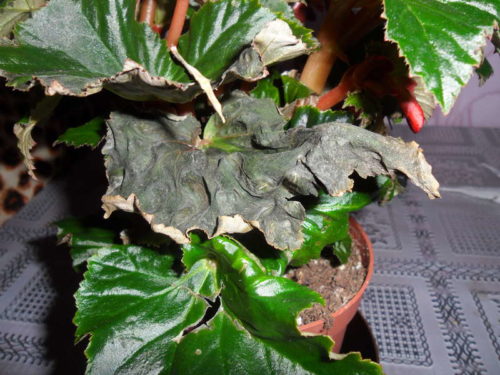
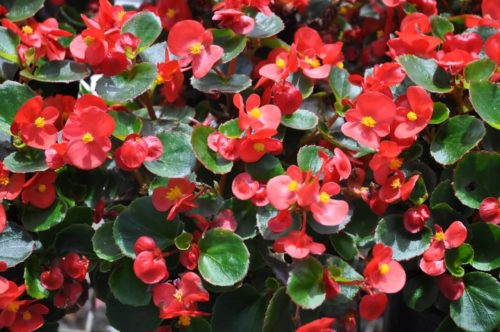
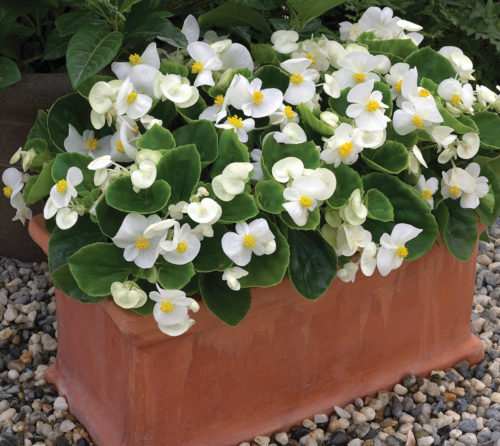
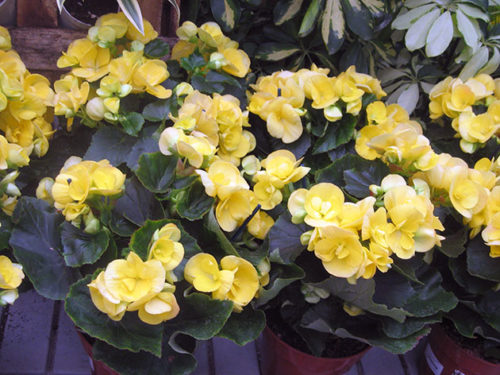














 Start a discussion ...
Start a discussion ...